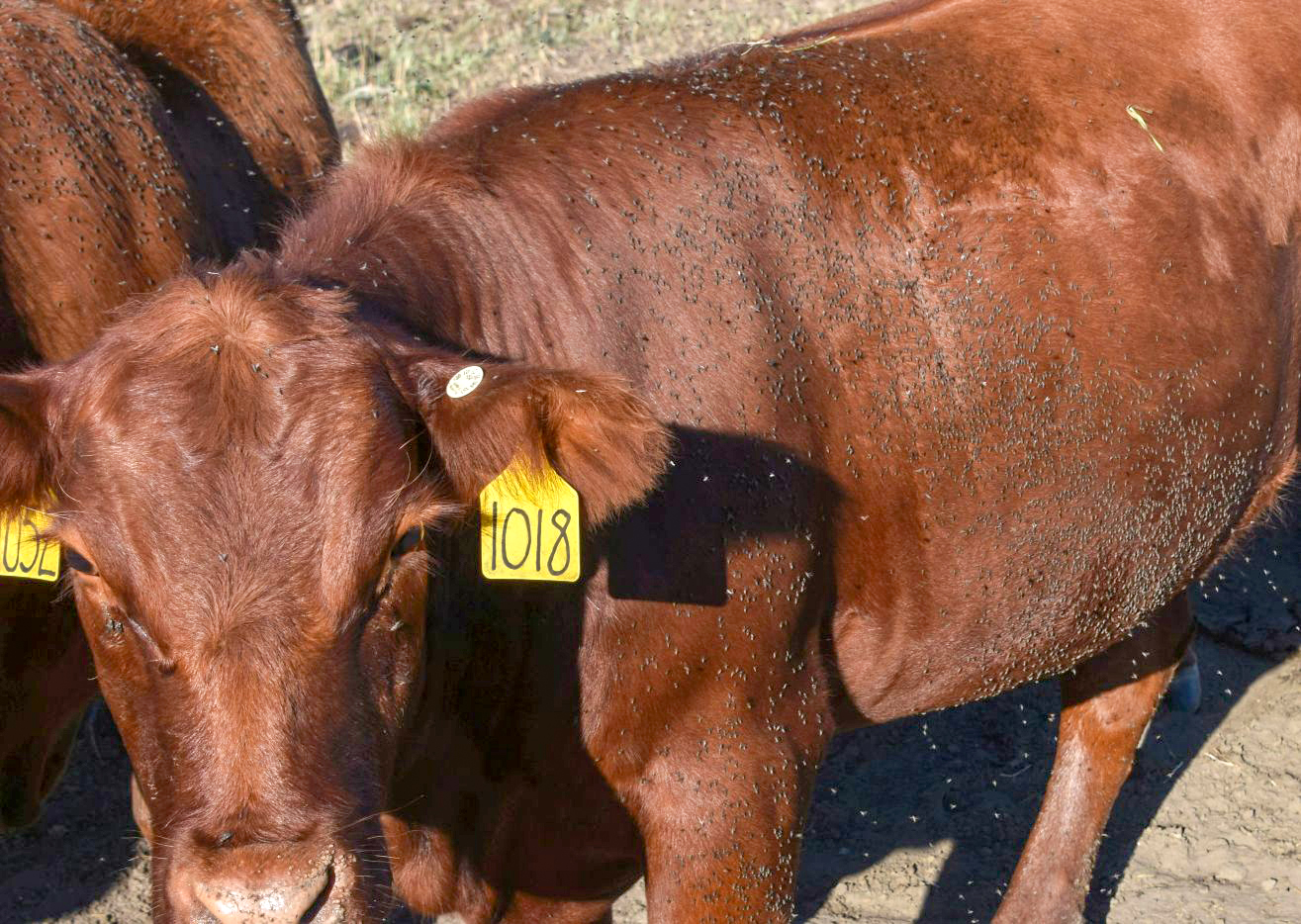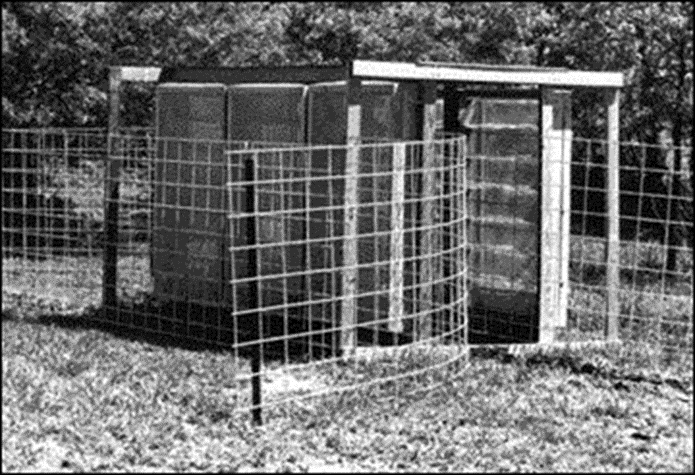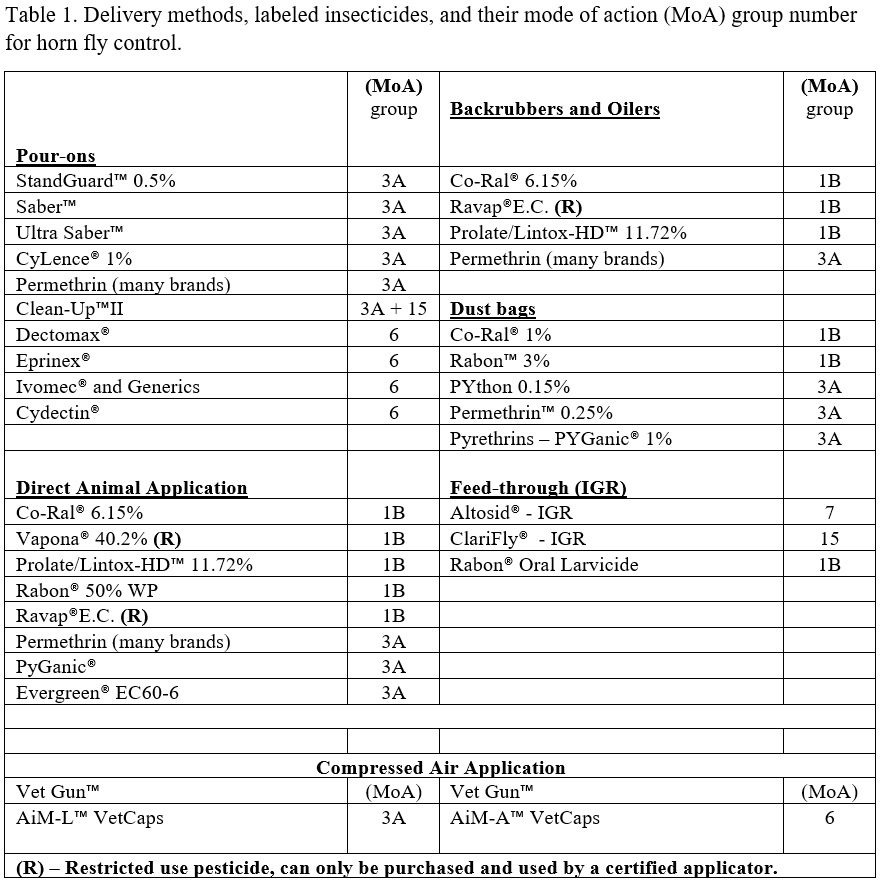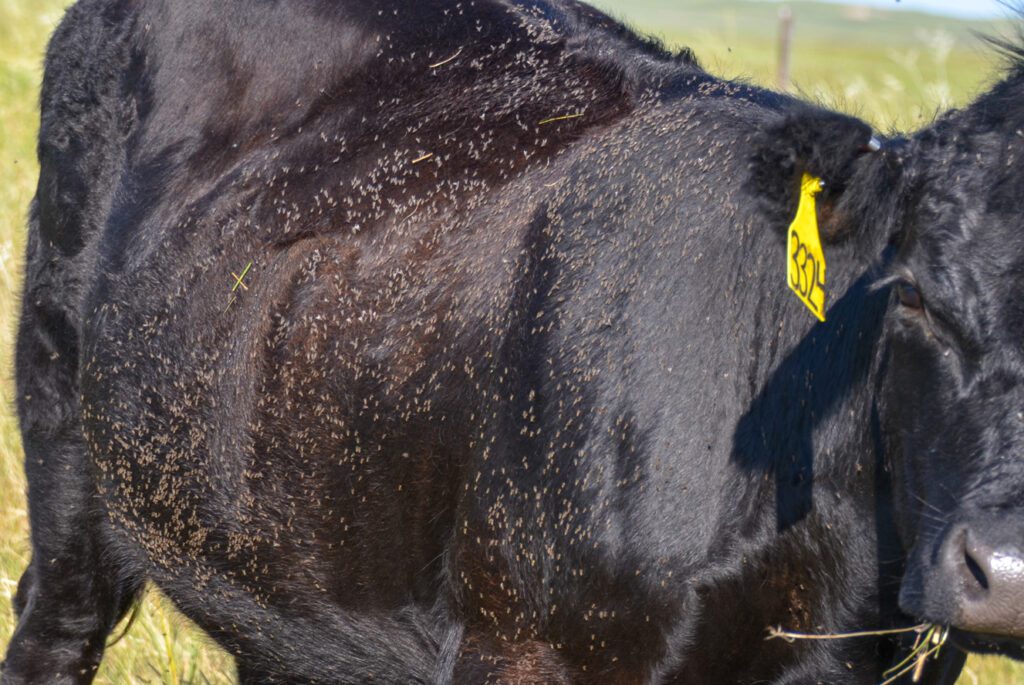Nebraska’s spring weather conditions have made it more difficult to predict the emergence of horn flies. If the current weather pattern continues, we should start to see horn fly emergence in the southeast part of the state in early May, reaching northern Nebraska by late May. If we experience an abrupt and sustained warm-up, horn fly numbers could reach or exceed the Economic Injury Level (EIL) statewide by the end of May. The EIL represents a fly population of 200 flies per animal that negatively impacts cattle production enough to warrant paying for a fly control measure.
The horn fly (Figure 1) is a major pest of pasture and rangeland cattle in Nebraska and throughout the U. S. Once horn fly numbers surpass the EIL, cattle alter grazing patterns and behavior, reducing milk production and weight gain. In Nebraska, horn flies can be present on cattle well into September and early October, with thousands of flies per animal. Developing a comprehensive control program can reduce the horn fly’s impact.

Now is the time to develop or re-evaluate a horn fly management plan for 2023. First, look at last year’s plan. Did it provide adequate fly control? If fly control in 2022 was less than desired, now is the time to alter the plan and make necessary changes.
Selecting the most desirable control method for your operation will depend on efficacy, cost, convenience, and herd management practices. Current delivery methods to control horn flies are described below. Ensure animals have met any insecticide withdrawal periods before marketing. Regardless of the control method used, horn fly migration from neighboring untreated herds may mask the effectiveness of your treatment and may increase horn fly numbers above the economic injury level.
Dust bags
To effectively use dust bags, locate the bags so cattle must pass under them on their way to water, feed, or mineral. This can be accomplished by fencing around water tanks and suspending the bags in the entrance/exit openings. Studies have shown dust bags not placed in the forced-use arrangement provide 25 to 50 % less control. One dusting location with two bags treats approximately 50 to 60 cows.
Back rubbers and Oilers
As with dust bags, back rubbers and oilers are more effective when placed in a forced-use arrangement. Insecticides used with these devices should be mixed with No. 2 diesel fuel or mineral oil and should be recharged weekly. Do not use motor oil to dilute the insecticide; this will harm the cattle.
Pour-ons
Pour-ons are ready-to-use insecticide products applied in measured doses along the back line of animals. They reduce flies for several weeks, so re-application is required throughout the fly season depending upon horn fly pressure.
Animal Sprays
Insecticide sprays can be applied with low- and high-pressure sprayers or by mist blower sprayers. When using low- and high-pressure sprayers, cattle should be gathered and corralled to ensure adequate spray coverage. Mist blower applications are made in the pasture where cattle are grazing, thus reducing animal stress related to gathering and penning cattle. Animal sprays will provide 7 to 14 days of control and will need to be re-applied throughout the fly season.
Oral larvicides (feed additives)
Oral larvicides, such as feed additives, or Insect Growth Regulators (IGRs) are insecticides incorporated into mineral blocks, tubs, or loose mineral. These products prevent developing horn fly larvae in manure pats from becoming adults. Oral larvicides are effective when consumed in sufficient quantities throughout the fly season and should be presented to cattle 30 days prior to the start of fly season. These types of control products have no effect on adult flies.
Insecticide Ear Tags
Ear tags have one or more insecticides embedded in a plastic matrix. Movement of the head or grooming of the animal slowly releases small amounts of insecticide over time that travels through the hair coat of the animal. In Nebraska, ear tags should be applied during the last week of May or the first week of June to achieve maximum control through fly season. Ear tags applied too early decline in efficacy while fly numbers are still high. Adult animals and calves should receive the number of tags recommended on the product label. Tagging only the calf and not the cow will not provide the desired level of horn fly control.
Compressed Air Application
The Vet Gun™, a device like a paintball gun, applies an individual capsule of insecticide (VetCap) to an animal and can provide horn fly control between 10 to 35 days. VetCaps can be used on beef cattle weighing at least 600 lbs.
Traps
Traps do just that –physically capture horn flies. The Bruce fly trap (Figure 2) is a walk-through system where cattle enter through either end, pass through a 10-foot trap area, and contact a series of strips made of canvas or old carpet. These strips dislodge most of the horn flies on the animal’s topline and sides. Since Horn flies are attracted to light, disturbed flies move to the top of the trap where they are captured. The animal exits the trap with fewer flies on it, and the trapped flies cannot escape. Repeated use of the trap can reduce the overall local horn fly population. Like dust bags and oilers, the Bruce trap is best employed in a force-use situation where cattle must pass through it on a regular basis. Field studies conducted in North Carolina in 2022 showed the trap reduced horn flies by 41%. For more information or how to get plans to build a Bruce fly Trap, please contact me at dboxler1@unl.edu or 308-696-6721.

A list of different delivery methods, labeled insecticides, and their mode of action (MoA) group number for horn fly control are found in (Table 1).

Source: Institute of Agriculture and Natural Resources – UNL Beef, Dave Boxler, Nebraska Extension Educator, T.L. Meyer, Nebraska Extension Educator








